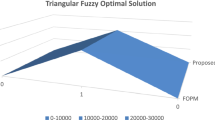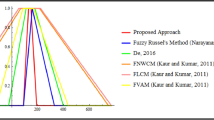Abstract
Sudhagar and Ganesan (Optim Eng, 2012, doi:10.1007/s11081-012-9202-6) proposed an approach to find the fuzzy optimal solution of such fuzzy transportation problems in which all the parameters are represented by fuzzy numbers. In this note, it is pointed out that the authors have used some mathematical incorrect assumptions in their proposed method.
Similar content being viewed by others
Avoid common mistakes on your manuscript.
1 Introduction
Sudhagar and Ganesan (2012, Sect. 3) proposed an approach to find the optimal solution of the fuzzy transportation problem (P1) (2012, Eq. 10, Sect.] 3.1). In this approach, the authors have assumed that problem (P2) (2012, Eq. 12, Sect. 3.1) is the fuzzy dual of problem (P1) and used it to find the fuzzy optimal solution of problem (P1).
\( v_{i} \,,w_{j} \) are unrestricted.
The authors have used the following method to obtain problem (P2).
-
Step 1: The problem (P1) can be transformed into problem (P3).
$$ \begin{aligned} & {\text{Minimize}} \left( {Score\left( {\mathop \sum \limits_{i = 1}^{p} \mathop \sum \limits_{j = 1}^{q} {\tilde{c}}_{ij} {\tilde{x}}_{ij} } \right)} \right) \\ & {\text{Subject to}} \\ & Score\left( {\mathop \sum \limits_{j = 1}^{q} {\tilde{x}}_{ij} } \right)\, \le \, Score\left( {{\tilde{M}}_{i} } \right),\quad i = 1,2,3, \ldots ,p;\quad \quad \quad \quad \quad ({\text{P}}_{3} ) \\ & Score\left( {\mathop \sum \limits_{i = 1}^{p} {\tilde{x}}_{ij} } \right)\, \ge \,Score\left( {{\tilde{D}}_{j} } \right), \quad j = 1,2,3, \ldots ,q; \\ & Score\left( {{\tilde{x}}_{ij} } \right)\, \ge \,0\quad\quad \forall i,j. \\ \end{aligned} $$ -
Step 2: The problem (P3) can be transformed into problem (P4).
$$ \begin{aligned} & {\text{Minimize }}\left( {\mathop \sum \limits_{i = 1}^{p} \mathop \sum \limits_{j = 1}^{q} Score\left( {{\tilde{c}}_{ij} {\tilde{x}}_{ij} } \right)} \right) \\ & {\text{Subject to}} \\ &\mathop { \sum }\limits_{j = 1}^{q} Score\left( {{\tilde{x}}_{ij} } \right)\, \le \,Score\left( {{\tilde{M}}_{i} } \right),\quad i = 1,2,3, \ldots ,p;\quad \quad \quad \quad \quad ( {\text{P}}_{ 4} )\\ & \mathop { \sum }\limits_{i = 1}^{p} Score\left( {{\tilde{x}}_{ij} } \right)\, \ge \, Score\left( {{\tilde{D}}_{j} } \right), \quad j = 1,2,3, \ldots ,q; \\ & Score\left( {{\tilde{x}}_{ij} } \right)\, \ge \,0\quad\quad \forall i,j. \\ \end{aligned} $$ -
Step 3: The problem (P4) can be transformed into problem (P5).
$$ \begin{aligned} & {\text{Minimize }}\left( {\mathop \sum \limits_{i = 1}^{p} \mathop \sum \limits_{j = 1}^{q} \left( {Score\left( {{\tilde{c}}_{ij} } \right)} \right)\left( {Score\left( {{\tilde{x}}_{ij} } \right)} \right)} \right) \\ & {\text{Subject to}} \\ &\mathop { \sum }\limits_{j = 1}^{q} Score\left( {{\tilde{x}}_{ij} } \right) \le Score\left( {{\tilde{M}}_{i} } \right), \quad i = 1,2,3, \ldots ,p;\quad \quad \quad \quad \quad ( {\text{P}}_{ 5} )\\ &\mathop { \sum }\limits_{i = 1}^{p} Score\left( {{\tilde{x}}_{ij} } \right) \ge Score\left( {{\tilde{D}}_{j} } \right), \quad j = 1,2,3, \ldots ,q; \\ & Score\left( {{\tilde{x}}_{ij} } \right) \ge 0\quad\quad \forall i,j. \\ \end{aligned} $$ -
Step 4: Since, Score of a fuzzy number is a real number. So, assuming \( Score\left( {{\tilde{c}}_{ij} } \right) = c_{ij} \), \( Score\left( {{\tilde{x}}_{ij} } \right) = x_{ij} \), \( Score\left( {{\tilde{M}}_{i} } \right) = M_{i} \) and \( Score\left( {{\tilde{D}}_{j} } \right) = D_{j} \), the problem (P5) can be transformed into problem (P6).
$$ \begin{aligned} & {\text{Minimize}} \left( {\mathop \sum \limits_{i = 1}^{p} \mathop \sum \limits_{j = 1}^{q} c_{ij} x_{ij} } \right) \\ & {\text{Subject to}} \\ &\mathop { \sum }\limits_{j = 1}^{q} x_{ij} \le M_{i} , \quad i = 1,2,3, \ldots ,p;\quad \quad \quad \quad \quad ( {\text{P}}_{ 6} )\\ &\mathop { \sum }\limits_{i = 1}^{p} x_{ij} \ge D_{j} , \quad j = 1,2,3, \ldots ,q; \\ & x_{ij} \ge 0 \quad \forall i,j. \\ \end{aligned} $$ -
Step 5: Assuming \( \mathop \sum \limits_{i = 1}^{p} M_{i} = \mathop \sum \limits_{j = 1}^{q} D_{j} \) (Balanced transportation problem), the problem (P8) can be transformed into problem (P7).
$$ \begin{aligned} & {\text{Minimize }}\left( {\mathop \sum \limits_{i = 1}^{p} \mathop \sum \limits_{j = 1}^{q} c_{ij} x_{ij} } \right) \\ & {\text{Subject to}} \\ &\mathop { \sum }\limits_{j = 1}^{q} x_{ij} = M_{i} , \quad i = 1,2,3, \ldots ,p;\quad \quad \quad \quad \quad ( {\text{P}}_{ 7} )\\ &\mathop { \sum }\limits_{i = 1}^{p} x_{ij} = D_{j} ,\quad j = 1,2,3, \ldots ,q; \\ & x_{ij} \ge 0\,\,\,\quad\forall i,j. \\ \end{aligned} $$ -
Step 6: The dual of the problem (P7) is problem (P8)
$$ \begin{aligned} & {\text{Maximize}} \left( {\mathop \sum \limits_{i = 1}^{p} M_{i} v_{i} + \mathop \sum \limits_{j = 1}^{q} D_{j} w_{j} } \right) \\ & {\text{Subject to}}\\ & v_{i} + w_{j} \le c_{ij} ,\quad i = 1,2,3, \ldots ,p; \quad j = 1,2,3, \ldots ,q.\quad\quad\quad\quad ({\text{P}}_{ 8} ) \end{aligned} $$\( v_{i} \,,w_{j} \) are unrestricted.
-
Step 7: Replacing \( c_{ij} = Score\left( {{\tilde{c}}_{ij} } \right) \), \( x_{ij} = Score\left( {{\tilde{x}}_{ij} } \right) \), \( M_{i} = Score\left( {{\tilde{M}}_{i} } \right) \) and \( D_{j} = Score\left( {{\tilde{D}}_{j} } \right) \), the problem (P8) can be transformed into problem (P9)
$$ \begin{aligned} & {\text{Maximize}} \left( {\mathop \sum \limits_{i = 1}^{p} Score\left( {{\tilde{M}}_{i} } \right)v_{i} + \mathop \sum \limits_{j = 1}^{q} Score\left( {{\tilde{D}}_{j} } \right)w_{j} } \right) \\ & {\text{Subject to}} \\ & v_{i} + w_{j} \le Score\left( {{\tilde{c}}_{ij} } \right),\quad i = 1,2,3, \ldots ,p;\quad j = 1,2,3, \ldots ,q.\quad \quad \quad \quad ({\text{P}}_{ 9} ) \end{aligned} $$\( v_{i} \,,w_{j} \) are unrestricted.
-
Step 8: The problem (P9) can be transformed into problem (P10)
$$ \begin{aligned} & {\text{Maximize}}\left( { Score\left( {\mathop \sum \limits_{i = 1}^{p} {\tilde{M}}_{i} v_{i} + \mathop \sum \limits_{j = 1}^{q} {\tilde{D}}_{j} w_{j} } \right)} \right) \\ & {\text{Subject to}}\\ & v_{i} + w_{j} \le Score\left( {{\tilde{c}}_{ij} } \right) ,\quad i = 1,2,3, \ldots ,p; \quad j = 1,2,3, \ldots ,q.\quad \quad \quad \quad ({\text{P}}_{10} ) \end{aligned} $$\( v_{i} \,,w_{j} \) are unrestricted.
-
Step 9: The problem (P10) can be transformed into problem (P11) (or P2)
$$ \begin{aligned} & {\text{Maximize}}\left( { \mathop \sum \limits_{i = 1}^{p} {\tilde{M}}_{i} v_{i} + \mathop \sum \limits_{j = 1}^{q} {\tilde{D}}_{j} w_{j} } \right) \\ & {\text{Subject to}}\quad \quad \quad \quad \quad \quad \quad \quad \quad \quad \quad \quad \quad \quad \quad \quad \quad \quad \quad \quad ({\text{P}}_{11} ) \\ & v_{i} + w_{j} \le Score\left( {{\tilde{c}}_{ij} } \right),\quad i = 1,2,3, \ldots ,p;\quad j = 1,2,3, \ldots ,q. \\ \end{aligned} $$\( v_{i} \,,w_{j} \) are unrestricted.
2 Mathematically incorrect assumptions considered in writing the fuzzy dual
The authors (Sudhagar and Ganesan 2012) have used the following mathematical incorrect assumptions in wring the fuzzy dual of problem (P1):
-
1.
It can be easily verified that for any two fuzzy numbers \( \mathop {\tilde{A}}\limits^{{}} \) and \( \mathop {\tilde{B}}\limits^{{}} \) the property \( Score\left( {\mathop {\tilde{A}}\limits^{{}} + \mathop {\tilde{B}}\limits^{{}} } \right) = Score(\mathop {\tilde{A}}\limits^{{}} ) + Score(\mathop {\tilde{B}}\limits^{{}} ) \) is not necessarily satisfied. However, it is obvious from Sect. 2 that in Step 2, the authors (Sudhagar and Ganesan 2012) have used this property to transform the problem (P3) into problem (P4).
-
2.
It can be easily verified that for any two fuzzy numbers \( \mathop {\tilde{A}}\limits^{{}} \) and \( \mathop {\tilde{B}}\limits^{{}} \) the property \( Score\left( {\mathop {\tilde{A}}\limits^{{}} \mathop {\tilde{B}}\limits^{{}} } \right) = Score(\mathop {\tilde{A}}\limits^{{}} )Score(\mathop {\tilde{B}}\limits^{{}} ) \) is not necessarily satisfied. However, it is obvious from Sect. 2 that in Step 3, the authors (Sudhagar and Ganesan 2012) have used this property to transform the problem (P4) into problem (P5).
3 Error in existing method
It is obvious from Theorem 1 (2012, Sect. 3.2) as well as Step 6 to Step 9 (2012, Sect. 3.2) that the authors have obtained the fuzzy optimal solution of problem (P1) with the help of its fuzzy dual (P2). However, as discussed in Sect. 2 that the authors (Sudhagar and Ganesan 2012) have used some mathematical incorrect assumptions for obtaining problem (P2). So, there is error in the existing method (Sudhagar and Ganesan 2012). Hence, it not genuine to use the existing method (Sudhagar and Ganesan 2012) to obtain the fuzzy optimal solution of fuzzy transportation problem (P1).
Reference
Sudhagar C, Ganesan K (2012) A fuzzy approach to transport optimization problem. Optim Eng. doi:10.1007/s11081-012-9202-6
Acknowledgement
I, Dr. Amit Kumar, would like to acknowledge the adolescent blessings of Mehar (lovely daughter of my cousin sister Dr. Parmpreet Kaur). I believe that Mata Vaishno Devi has appeared on the earth in the form of Mehar and without Mehar’s blessings it was not possible to think the ideas presented in this manuscript.
Author information
Authors and Affiliations
Corresponding author
Rights and permissions
About this article
Cite this article
Sidhu, S.K., Kumar, A. & Kaur, A. A note on “A fuzzy approach to transport optimization problem”. Optim Eng 17, 987–992 (2016). https://doi.org/10.1007/s11081-015-9279-9
Received:
Accepted:
Published:
Issue Date:
DOI: https://doi.org/10.1007/s11081-015-9279-9




